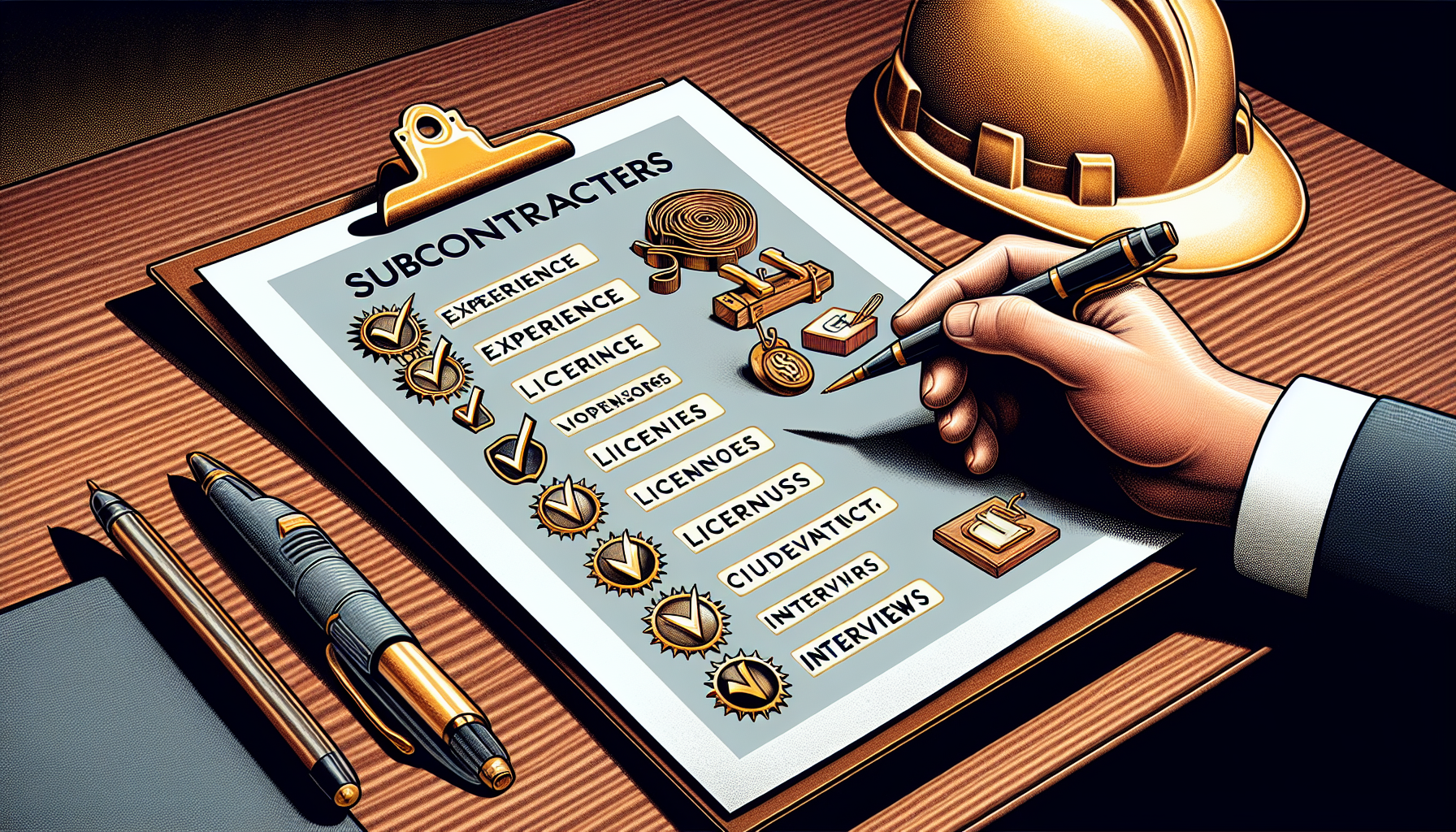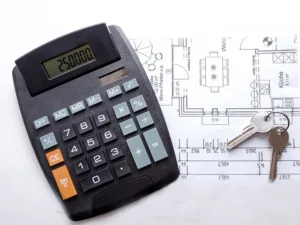If you’re on the hunt for top-notch subcontractors, you know the challenges of finding qualified professionals who fit your timeline and budget. Our guide simplifies your search. We detail the steps on how to find subcontractors, from leveraging networks to using digital tools, ensuring you connect with the right talent for your project. Prepare to navigate the subcontractor landscape with confidence.
Table of Contents
Key Takeaways
Identifying quality subcontractors involves engaging industry networks, leveraging referrals, and utilizing digital platforms, ensuring a harmonious team that aligns with the project’s vision.
Vetting potential subcontractors is a multi-faceted process that includes evaluating past performance, verifying credentials and safety records, and assessing cultural fit to ensure a reliable and professional team.
Legal considerations when hiring subcontractors are crucial, including understanding contractual obligations, ensuring compliance with labor laws and insurance requirements, and having clear protocols for dispute resolution and change orders.
Scouting for Quality Subcontractors in the Construction Industry

Any construction project’s success hinges not only on the detailed plans and dimensions but also heavily on securing quality subcontractors recognized for their craftsmanship and exactitude. Selecting subpar subcontractors can precipitate unwelcome delays, budgetary excesses, and ultimately a deficient edifice. Conversely, assembling an exemplary cadre of construction workers ensures that every piece falls into place seamlessly—turning blueprints into realized architectural achievements.
The quest to discover these critical contributors is complex, entailing diligent exploration through three pivotal channels: tapping into professional networks within the industry, leveraging recommendations from trusted sources, and taking advantage of contemporary online platforms. Each method offers distinct benefits. When combined astutely, they pave the way to enlisting the finest subcontractors available for your projects.
Leveraging Industry Networks and Trade Organizations
Have you ever pondered the potential that lies within your professional network for discovering a wealth of subcontractor expertise? Tapping into industry connections and affiliations with trade organizations can be incredibly effective in nurturing relationships, which may lead to successful subcontractor engagement. Participation in entities such as the Associated Builders and Contractors (ABC) or the Associated General Contractors of America (AGC) doesn’t just broaden your network—it also grants you entry into a community dedicated to maintaining high-quality standards and upholding professionalism.
When attending local trade shows and other industry gatherings, simple conversations could lay the foundation for future partnerships. The act of sharing business cards might mark the beginning of prosperous cooperation between parties. It’s important not to underestimate this interaction. It’s akin to a dance built on mutual respect where each meeting has the potential to uncover a new expert ready to bring their specialized skills to bear on your projects. A firm handshake or an opportune recommendation holds significant power—within these settings lies the possibility that your ideal general contractor is simply one introduction away.
The Power of Referrals from Previous Clients and Peers
In the realm of construction, endorsements from former clients or industry associates are incredibly valuable. These recommendations come with a stamp of legitimacy because they’re based on direct experience and vouched for by credible individuals. When someone who has previously worked in harmony with a subcontractor advocates for their services, it is an affirmation of that subcontractor’s capacity to execute work to high standards.
Think about being handed the contact information of a subcontractor by someone you respect professionally—an individual known for handling projects effortlessly and efficiently. This isn’t just helpful. It represents an intentional effort to link you up with reliable subcontractors, renowned for their punctuality and exceptional performance. Leveraging this circle of vetted experts not only spares you time, but also gives you peace, knowing that every detail will be managed expertly while your attention can remain directed towards overarching project goals.
Digital Platforms: A Modern Approach to Finding Subs

In the contemporary world of digital technology, the quest for securing skilled subcontractors has evolved. Digital marketplaces such as Upwork, Angi, and Construction Connect have become indispensable tools in a general contractor’s repertoire when searching for specialized expertise. These online resources not only offer ease but also present access to an expansive selection of potential subcontractors beyond what traditional approaches could yield.
The digital landscape facilitates a more efficient hiring process regardless of whether you need an electrical sub or someone to lay tile. Platforms are equipped with intuitive interfaces and comprehensive profiles that consolidate information like work history, qualifications, and client evaluations all within easy reach. This method streamlines your ability to cast a broad search net efficiently and identify top-tier subcontractors tailored to fulfill the unique requirements of your construction project.
The Art of Vetting Potential Subcontractors

Once you’ve scouted a list of potential candidates, the real artistry lies in the vetting process. This critical stage requires a discerning eye and a systematic approach to ensure that your project is entrusted to the most capable hands. The vetting process involves more than just verifying qualifications; it entails:
Uncovering the subcontractor’s genuine capacity to contribute to your project’s success
Assessing their experience and expertise in similar projects
Checking their references and past client feedback
Evaluating their communication and collaboration skills
Reviewing their financial stability and insurance coverage
By thoroughly vetting your experienced subcontractors, you can minimize risks and increase the chances of a successful project outcome. To find quality subcontractors, it’s crucial to conduct a comprehensive evaluation of their skills and expertise before you hire subcontractors. One effective way to do this is to solicit bids from potential candidates, allowing you to compare their proposals and make an informed decision.
The vetting process encompasses several key areas:
Evaluating experience and past performance
Checking for proper licensing and insurance
Conducting in-depth interviews to assess cultural fit and communication skills
Each of these steps is a brushstroke in the larger picture of your project, contributing to a detailed and nuanced portrait of each potential subcontractor.
Evaluating Experience and Past Performance
In evaluating the appropriateness of a subcontractor, their previous experience and performance track record serve as critical metrics for predicting their potential effectiveness. This analysis goes beyond simply perusing through a CV. It involves an in-depth look at their project history to assess the breadth and complexity they have previously handled. By reviewing what they have accomplished and the hurdles they have overcome, you can determine if they possess the capability to fulfill your specific project needs.
This scrutiny encompasses more than just flipping through past work samples – it necessitates reaching out to references while also scrutinizing financial stability and payment records of the subcontractor. It’s crucial that this background check confirms not only that they are impressive but also aligned with what your endeavor demands. A skilled residential specialist might not translate well into large-scale commercial ventures—and conversely, an understanding is essential when selecting an appropriate subcontractor for your undertaking.
Checking Licenses, Insurance, and Safety Records
The credibility of a subcontractor is anchored in their valid licenses, comprehensive insurance coverage, and proven safety records. These essential documents serve as protective measures for your project, mitigating the risks of legal and financial complications. Making sure that a subcontractor possesses all required licenses verifies their conformity to professional standards and confirms they have received adequate training for safe and proficient task execution.
Having both general liability insurance and workers’ compensation is not merely procedural. It provides an important layer of defense for the subcontractor as well as the general contractor against unforeseen incidents. A commendable safety record, affirmed by EMR (Experience Modification Rate) verification and adherence to OSHA guidelines, significantly highlights a subcontractor’s dedication to maintaining a secure work environment on the job site. Diligent attention to these elements during the hiring process lays down a reliable groundwork guaranteeing that responsibility will be paramount in your construction endeavor.
Conducting Interviews for Cultural Fit and Communication Skills
An interview with a potential subcontractor is more than an exchange of information; it’s an opportunity to connect on a human level. Here, you’re not only assessing their technical abilities but also their cultural fit within your existing team. The goal is to identify someone who aligns with your work ethic, comprehends your project’s vision, and communicates effectively.
During the interview, pay close attention to how they describe their approach to collaboration and problem-solving. Are they adaptable, respectful, and open to feedback? Do they demonstrate clear communication skills and a willingness to align with your project’s goals? These qualities are the glue that holds a project together, ensuring seamless integration into your team and a harmonious work environment.
Aligning Project Needs with Subcontractor Services
Finding the right subcontractor is akin to solving a complex equation; every variable must be accounted for to achieve the desired outcome. It’s essential to align your project’s needs with the services offered by subcontractors, ensuring that their skills and resources are a perfect match for your project’s specifications. This alignment goes beyond mere capability; it’s about synergy, fostering a dynamic where the subcontractor’s strengths enhance the entire project.
To achieve this, you must clearly define the scope of work, establish a fair price and payment terms, and set precise expectations for project timelines and milestones. Each of these components plays a critical role in creating a harmonious relationship between the subcontractor and the project at hand, like a well-tuned instrument in an orchestra.
Defining the Scope of Work Clearly

Every subcontractor relies on the scope of work as their blueprint, detailing their specific duties within your project. This critical document doesn’t only list tasks. It sets forth the expectations regarding quality and performance standards. When the scope is clearly articulated, it acts as a navigational tool for subcontractors to adeptly handle project intricacies while staying focused on key details.
The creation of an explicit scope of work necessitates a cooperative approach, drawing from the collective knowledge of all involved stakeholders. The inclusion of input from subcontractors enriches this document with practical insights that ensure objectives are grounded in reality and can be successfully met. Such well-rounded clarity serves as a safeguard against cost overruns and project delays, thereby ensuring that timelines are adhered to and financial plans remain intact.
Establishing Payment Schedule and Terms
In the realm of construction, the movement of money significantly underscores the level of trust and esteem shared between a general contractor and their subcontractors. It is vital for fostering healthy cash flow dynamics and assuring that subcontractors receive timely and equitable remuneration to have a transparent payment schedule along with clearly delineated terms. This financial blueprint not only demonstrates your dedication to a professional work ethic, but also establishes respect within working relations.
By tying payment installments directly to defined progress milestones within the project, you create an incentive for subcontractors to adhere strictly to deadlines while upholding superior quality standards in their workmanship. Setting out these payment conditions from the get-go can stave off confusion or conflict down the line, thereby enabling all parties involved—both contractors and subcontractor teams—to concentrate on excelling in their craft instead of being preoccupied by uncertainties about forthcoming payments.
Setting Expectations for Project Timeline and Milestones
In the construction industry, time is often an invaluable commodity. Establishing explicit expectations for project timelines and significant milestones helps align the entire team’s efforts towards shared objectives. Subcontractors play a crucial role in ensuring your project operates smoothly. When they work together harmonically, exceptional outcomes are achieved.
Continuous monitoring of project advancements using key performance indicators provides insights into how subcontractors are performing, allowing you to rectify any deviations from set plans promptly. This consistent oversight not only keeps the progress on track, but also emphasizes the importance of adhering to deadlines and producing high-quality work. By instilling these standards from the start, you promote a culture where accountability and superior craftsmanship become fundamental values embraced by all layers within the undertaking.
Building and Managing Your Subcontracting Team
Crafting a squad of subcontractors is akin to orchestrating an ensemble for a theatrical production – each participant needs to grasp their specific duty and execute it with exactness. It’s not just the individual prowess but also the symphony among them that ultimately shapes the outcome of the endeavor. To steer your team of subcontractors towards collective brilliance requires a maestro’s finesse, melding each separate performance into one cohesive whole.
In this creative process, you are tasked with synchronizing timelines, implementing robust collaborative tools, and fostering constant communication channels. These fundamental duties lay the groundwork for adept team management—assuring that every member serving as a subcontractor possesses both the skill set required and unwavering dedication to bring forth our shared goal on stage at job sites everywhere. We’re about to delve into how these tenets play out in real-world construction scenarios.
Coordinating Multiple Subcontractors on the Job Site
The construction site serves as the arena for various subcontractors to showcase their expertise, and you’re tasked with making sure that everyone is in sync. It’s a complex juggling act to synchronize the activities of multiple subcontractors, carefully fitting their individual timelines into the broader schedule of the project. This synchronization is crucial to avoid workflow disruptions and ensures that tasks are completed in proper order.
Part of this intricate coordination requires you to monitor each subcontractor’s output while providing direction and oversight where necessary. By staying actively involved with every subcontractor on site, your role becomes pivotal in knitting together disparate elements of the project – reducing misunderstandings and enhancing productivity along the way. Your direct involvement not only smooths out operations, but also helps build unity and cooperative spirit among different specialties working on-site.
Tools and Techniques for Effective Subcontractor Collaboration

In the current era of digital advancement, a plethora of tools are available that are specifically designed to improve teamwork and enhance efficiency in managing projects. These platforms facilitate tracking developments, exchanging updates, and handling documentation collectively. By adopting these technologies, you establish an integrated nucleus for information exchange where everyone involved remains well-informed about every aspect.
For example, when you implement a robust quality management system, it lays down a structure enabling subcontractors to evaluate their own work critically and strive for ongoing enhancement. Utilizing checklists and inspection sheets as benchmarks allows for gauging performance accurately, which fosters an environment steeped in high standards and responsibility. With all subcontractors aligned with the project’s goals through this approach, it greatly increases the likelihood of achieving success.
Maintaining Open Lines of Communication
In the complex choreography of building projects, effective communication acts as a rhythm that keeps each participant moving in harmony. Engaging with subcontractors through transparent and clear exchanges does more than simply passing messages. It creates a bedrock of trustworthiness. Subcontractors who believe their feedback is respected and understood tend to contribute more constructively to the endeavor and are quicker to signal any impending issues before they balloon into bigger complications.
To nurture such an environment, persistent touchpoints and receptiveness are key strategies. Setting up systematic gatherings for discussion and promoting an environment where team members can freely express their worries helps cultivate a cooperative space wherein obstacles can be dealt with expeditiously. Prompt acknowledgment of exemplary work combined with immediate resolution of problems not only elevates spirits but also fortifies the caliber of excellence anticipated at your job site.
Legal Considerations When Hiring Subcontractors
When hiring and managing subcontractors in the construction business, it is critical to pay close attention to legal guidelines. The industry teems with intricate challenges, and a keen understanding of legal details can be the key to preventing turbulence throughout your project’s journey. Addressing all elements from contract creation to adherence to employment legislation is crucial for safeguarding both your venture and company.
Clarity reigns supreme within the realm of construction law. Crafting clear-cut contracts delineates expectations and duties while thorough record-keeping reinforces these agreements’ legitimacy and allows you to track every transaction meticulously. To ensure you’re equipped for navigating the complexities of legally engaging subcontractors, let’s explore these specific considerations that will empower you as you tackle this aspect of managing your construction operations confidently.
Understanding Contractual Obligations
The contract serves as a guide that outlines the role of each subcontractor within your project, providing explicit instructions on job responsibilities, adherence to quality standards, and timelines for payments. This document acts as a constant point of reference over the course of the work undertaken. Yet it’s more than mere verbiage. This contract represents an enforceable pact requiring all involved parties to honor their promises.
To preserve alignment between the primary agreement and those with subcontractors, clauses are mirrored down from one to another—this strategy ensures uniformity while preventing any contractual conflicts. By incorporating clear terms regarding termination protocols and capping liability regarding client satisfaction into these agreements upfront, you can stave off potential disagreements later on, helping your project’s development proceed smoothly according to plan.
Ensuring Compliance with Labor Laws and Insurance Requirements
The subcontractor hiring process demands careful attention and adherence to the legal standards specific to each state. To assemble a team that conforms with legal mandates, it’s essential to verify that all subcontractors are properly licensed and registered. Such due diligence in this initial step is not simply procedural, but fundamental in affirming your project’s legitimacy.
Insurance plays an instrumental role in maintaining compliance with the law during the hiring process of subcontractors. Mandating that subs produce proof of insurance tailored to fit the needs of your project fortifies you against foreseeable liabilities. This vigilant strategy indicates a high level of due diligence while offering assurance that both parties enjoy protection thanks to sufficient insurance coverage.
Handling Dispute Resolution and Change Orders
No matter how well you plan, alterations and conflicts are a constant in the realm of construction. Setting up explicit protocols for these incidents can help stop small problems from growing into significant barriers. By having an established method involving mediation, arbitration, or resorting to the legal court system, one ensures that any disputes are settled both effectively and equitably.
On the other hand, change orders bring unexpected twists to the construction storyline. They require rigorous documentation to accurately capture changes as they occur within a project’s lifecycle. Keeping comprehensive records and demanding written consent minimizes confusion and protects the agreement initially set forth between parties involved. This meticulous approach to documentation is not only recommended but also essential for adeptly managing a successful project.
Summary
As we conclude our comprehensive guide, it’s evident that the art of mastering the subcontractor hiring process resembles leading an orchestral performance. Every phase, from initial scouting to considering legal aspects, is a crucial tone in your project’s harmony. By adhering to the strategies presented here, you are doing more than constructing buildings. You’re sculpting lasting monuments where each component — every beam, nail, and tile — serves as proof of your dedication to superior craftsmanship.
Embrace the understanding you have accumulated and let it bolster your confidence for upcoming projects. With this guide serving as your architectural plan, you stand prepared to pilot your ventures with proficiency effectively managing through intricate details involved in subcontractor hiring and ensuring that what is produced rings with unmatched quality and steadfastness.
Frequently Asked Questions
How do I know if a subcontractor is reliable and has a good track record?
To assess the reliability and solid track record of a subcontractor, scrutinize their portfolio, verify references, investigate their financial stability and examine their safety records to confirm they consistently produce quality work while adhering to deadlines.
What’s the best way to find quality subcontractors?
To locate subcontractors of high calibre, it is advisable to utilize professional networks within the industry, engage with trade organizations, and explore online platforms. Obtaining recommendations from colleagues and former clients can be a valuable resource.
These avenues are effective for identifying quality subcontractors who possess specialized expertise and have earned positive feedback from their engagements.
How should I handle payment schedules with subcontractors?
To maintain transparency and encourage subcontractors to keep to their deadlines, it’s essential to have a payment schedule that is both well-defined and linked directly to project milestones within the contract.
Having this structured approach will not only simplify your payment procedures, but also foster constructive relationships with your subcontractors.
What legal documents should I collect from a subcontractor before starting work?
Prior to initiating any engagement with a subcontractor, it is essential for the protection and legal adherence of your enterprise to gather a fully completed Form W-9, verify possession of sufficient insurance coverage through proof of insurance, and obtain a certificate demonstrating compliance with licensing regulations.
How can I prevent disputes with subcontractors?
To avoid disagreements with subcontractors, it is essential to formulate detailed contracts, ensure meticulous record-keeping, and set up explicit written guidelines for settling disputes and managing change orders. Consistent communication coupled with the swift resolution of problems also serves to reduce the likelihood of conflict.
Related posts
Read our other articles where you can find useful and relevant information about subcontractor management:
- 6 reasons to hire subcontractors in construction
- Types of Subcontractors in Construction
- Construction Subcontracting FAQ
- How to Set Up Contracts with Subcontractors: A Comprehensive Guide
- How to manage subcontractors in construction?
About the Author

Taavi Kaiv
Taavi Kaiv is a construction specialist with over ten years of experience in the construction industry. Taavi is an accomplished construction project manager with many successful projects that have been completed under his guidance. Taavi holds a master’s degree in construction management from the Tallinn University of Technology. View profile






